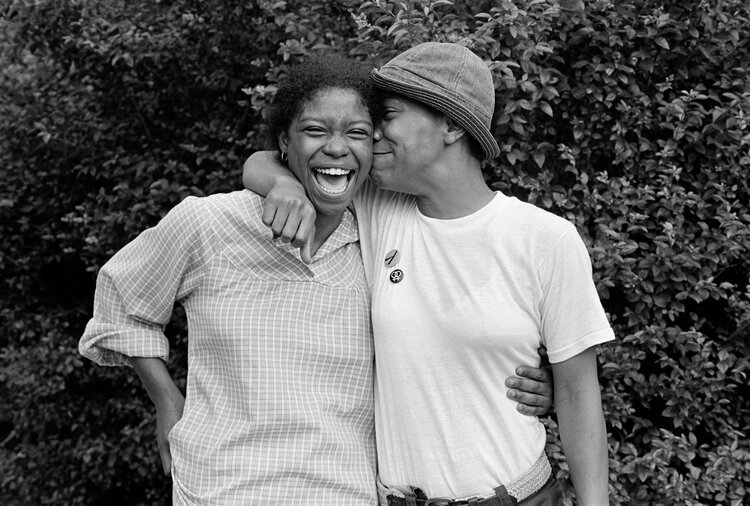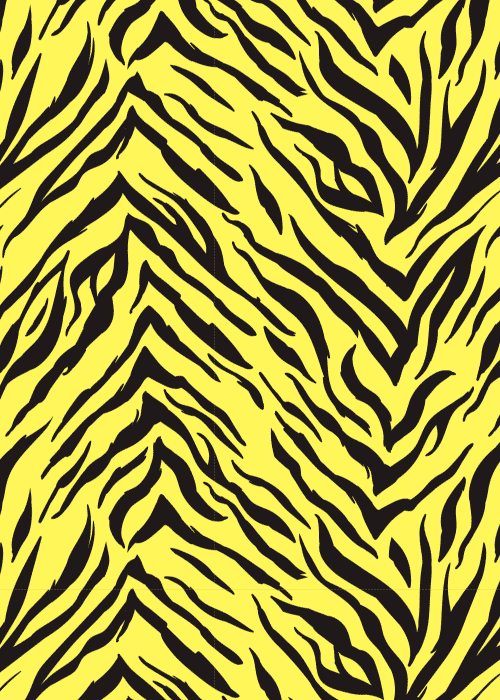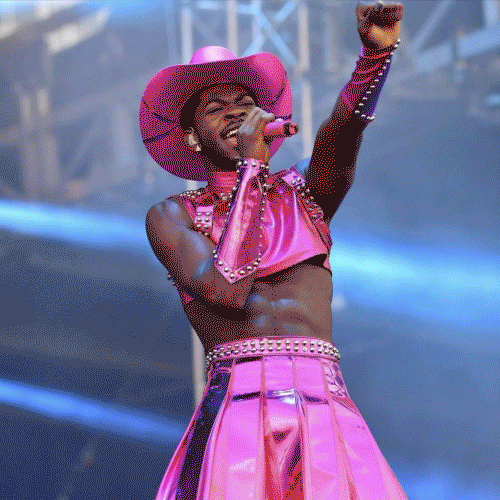The Lie-Abolishing Technology of JEB’s Eye to Eye
GLORIA AND CHARMAINE. BALTIMORE, MARYLAND. 1979
© JEB (JOAN. E. BIREN) FROM EYE TO EYE PORTRAITS OF LESBIANS
PUBLISHED BY ANTHOLOGY EDITIONS
When Joan E. Biren (better known as JEB) was putting together her 1979 monograph of lesbian portraits, Eye to Eye, she developed all the negatives by hand in her apartment. She didn’t dare send them to a commercial studio: had the developers taken issue with the images of women’s intimacy – and so many naked women that! – they could have simply confiscated the originals under obscenity law, and never given them back.
“So many of the horrible things that could be done to you were legal,” JEB told Slate recently.
Today, after many years out of print, Eye to Eye: Portraits of Lesbians has been re-issued by Anthology Editions. The new edition springs into a wildly different world than the one in which it was first published, where visual images of queerness were nearly non-existent. Yet the vibrant energy of JEB’s images and the sheer breadth of the project feel as fresh – and as necessary – as ever.
JEB set out to create Eye to Eye because there was no other book like it. “I couldn’t find images of lesbians that looked like any lesbians I knew,” she told a virtual audience in February at a Charis Circle event. At the time, visual representations of queer women were limited to whatever straight white men saw them as – and mostly, they saw them as sinister predators or vacuous, sexualized objects. “It was all monster scary porno images,” she noted wryly.
So JEB, who was living in Washington, D.C. and photographing the burgeoning gay liberation movement, decided she would document real lesbian life herself. She would make pictures of her friends, her friends’ friends, and friends of those friends, all over the country. In 1978, she drove coast-to-coast in a beat-up car, sleeping on acquaintances’ couches, flat broke and determined to give queer women a portrait of themselves.
LORI AND VALERIE. WASHINGTON, DC. 1978
© JEB (JOAN. E. BIREN) FROM EYE TO EYE PORTRAITS OF LESBIANS
PUBLISHED BY ANTHOLOGY EDITIONS
The resulting collection, widely acknowledged to be the first photo book about lesbians, by a lesbian, is at once tender and resolute. Its scale is mighty. “We didn’t have the word then, but our politics were intersectional,” JEB told Slate’s June Thomas. Here are women of all ages, Black and white and indigenous, rural farmers and dyke chefs and a sexy hard-hatted butch repairing an electrical wire from a cherry picker. Black lesbian activist sisters Beverly and Barbara Smith – legends of the day – lounge in their office, framed by a typewriter. A woman named Connie crosses a New York City intersection in her wheelchair, grinning into the sunshine with her hair blowing in the breeze. “There is a disabled closet as well as a Lesbian closet,” she writes in the text opposite her photo.
Each image is gorgeously specific, but the sum total of Eye to Eye approaches a unified whole. And in its gestures of intimacy and desire, that whole is avowedly queer. The title is lifted from the poem Transcendental Études by Adrienne Rich, an excerpt of which features as an epigraph:
two women, eye to eye
measuring each other’s spirit, each other’s
limitless desire,
a whole new poetry begins here.
The book’s unapologetically lesbian lens is congenital to the era of its birth. By the late ‘70s, the feminist movement had become a political maelstrom, rent from within by factionalism and the stubborn hegemony of middle-class white women. The lesbian movement sprang out of the women’s movement largely because straight women refused to acknowledge the existence of queer feminism. Though never a perfect ecosystem of power sharing, lesbian movements often achieved greater intersectionality than the mainstream women’s movement. And their politics were decidedly more radical. JEB herself helped to establish The Furies, a separatist lesbian collective in Washington, D.C unified by the belief that lesbianism was the most essential form of feminism.
PRISCILLA AND REGINA. BROOKLYN, NEW YORK. 1979
© JEB (JOAN. E. BIREN) FROM EYE TO EYE PORTRAITS OF LESBIANS
PUBLISHED BY ANTHOLOGY EDITIONS
Despite its radical context, Eye to Eye reads less like an act of political defiance and more as a quiet affirmation of lesbian existence. “We’re right here,” the photos seem to breathe. Here are queer women fixing cars and cooking dinner; here are queer women bathing and laughing with their children; here are queer women doing not very much at all. Of course, simply presenting lesbian life as quotidian was a radical political act, subversive in its undeniable realness.
“I did it because I wanted us to be able to see ourselves,” JEB explained at the Charis Circle event, in conversation with the poet and activist Alexis Pauline Gumbs. JEB told Gumbs she was inspired by Audre Lorde’s radiant exhortation to name things. “Poetry,” Lorde wrote, “is the way we help give name to the nameless so it can be thought.”
JEB made the photos in Eye to Eye as an act of visual naming. “If you show somebody something, that opens up possibility. That is transformative.” Gumbs, who is writing a book on Audre Lorde and whose work is grounded in the speculative literary traditions of Black queer women writers, called JEB’s work “lie-abolishing technology.” On the Zoom screen, she pulled up the photo Priscilla and Regina, in which two Black women sleep peacefully in each other’s arms, evidence of the truth-telling power of a single picture.
“Look at us!” Gumbs exclaimed. “It’s our life!”
In the years JEB was making her photos, those lies she set out to abolish were pervasive and totalizing. They were part of the psychic border wall that divided the moral from the deviant, the possible from the unimaginable.
Part of naming things, then, was to dismantle that border, to make possible the unimaginable. “People did not believe you could be a Black lesbian, or a lesbian mother,” JEB noted.
And yet, each photo murmurs. Here we are.
DARQUITA AND DENYETA. ALEXANDRIA, VIRGINIA. 1979
© JEB (JOAN. E. BIREN) FROM EYE TO EYE PORTRAITS OF LESBIANS
PUBLISHED BY ANTHOLOGY EDITIONS
In Darquita and Denyeta, love shimmers. The breakfast spoon Denyeta holds levitates in the air; she is, quite literally, feeding Darquita the truth about who a person can be. “She is a child of the world,” Denyeta says of her daughter in the accompanying text. “It’s like having the sun shine on me every morning.”
The women in JEB’s book did not reveal their lives without risk; to put their faces and names in print was to effectively out themselves to the world, make them vulnerable to disownment or eviction. They could have lost their children, their jobs, their lives. JEB spent days with each of the families and communities she photographed, building a relationship of trust before ever introducing a camera. She eschews the violence of traditional photography vernacular – armed with a camera, aiming the lens, shooting photos – as an inherently oppositional approach to photography, opting instead for the gentler syntax of “making” a photo. She never posed the individuals in her photos, and never dressed or undressed them. In fact, she told June Thomas, “if they were topless, I’d ask if they wanted me to be topless as well!”
Every woman in the book signed a consent form and chose how their name would appear in the text. When the printing house balked, terrified the women might sue the printers for outing them, JEB and her lawyer went back to each woman with another form giving the printing press immunity. (She could have published the book through a small gay & lesbian publishing house, but it would have meant printing the images on cheap newsprint, and JEB was determined to put them on high-quality, coated stock). To pay for publication, she gathered small loans from friends in the lesbian community; she saved money by camping out at the printers to check the proofs herself, rather than risk costly reprintings. If she’d she had any money, the project would have bankrupted her – but she was never in it for the money. “Capitalism isn’t going to reward you for doing things out of love,” she told Alexis Pauline Gumbs. “But the reward is so much better than that.”
And it was. The first 5,000 copies flew off bookstores’ shelves, selling out in three months. A second printing sold out shortly afterwards. Many books disappeared without being paid for, stolen by people who needed to the images but couldn’t afford to pay, or be seen paying. “I’m glad they did,” JEB says. That has been her goal, after all. To make the images more accessible, she printed cheap postcards, which sold across the country and became quiet semaphores of lesbianism, pasted to dorm walls and refrigerators doors, signaling to anyone who was looking for a sign.
PAGAN AND KADY. MONTICELLO, NEW YORK. 1978
© JEB (JOAN. E. BIREN) FROM EYE TO EYE PORTRAITS OF LESBIANS
PUBLISHED BY ANTHOLOGY EDITIONS
When JEB set out on a distribution tour, her mentor and fellow queer photographer Tee Corinne suggested she use some of the photos for a slide show. That slide show turned into a full-scale presentation, “Lesbian Images in Photography, 1850-The Present,” which JEB delivered all across America, often teaching women’s photography workshops along the way and making photographs for her next book.
“The Dyke Show,” as it came affectionately to be known, showed audiences hundreds of photos dating back to the earliest days of photography. Lacking definitive “proof” of the queerness of these long-ago artists and subjects, JEB’s slide shows instead invited their audiences to read the queer potential within the images; to impart, as Sophie Hackett wrote in Aperture Magazine, “a new, queer way of looking.” Carol Seajay, who cofounded the Old Wives Tales feminist bookstore in San Francisco, wrote that at the Dyke Show she’d seen “images I had never seen before, images I had seen and not perceived. Images on which to build a future.”
JANE. WILLITS, CALIFORNIA. 1977
© JEB (JOAN. E. BIREN) FROM EYE TO EYE PORTRAITS OF LESBIANS
PUBLISHED BY ANTHOLOGY EDITIONS
If in those early, heady days of gay and lesbian consciousness-raising, JEB’s photos helped lesbians imagine a future, those same photos have evolved into a record of the past. “I wanted lesbians in the future to feel like part of a lineage,” JEB told Alexis Pauline Gumbs. “To have some history.”
In that sense, the reissue of Eye to Eye joins the larger movement to bring long-sequestered queer history into the light. Archival projects have begun digitalizing their contents to share on social media; popular accounts like @lesbianherstoryarchives and @lgbt_history are teaching younger queer generations the stories of their elders. In a world now abundant with imagery, and amidst a revolution of visibility for marginalized communities, we owe a great deal to those who bravely showed themselves when it was safer to stay hidden. “We were right here,” these pictures breathe to us now. “We have always been here.”
As a photographer, and as an activist, JEB understood the imperative to make a record of that existence. Without careful preservation, how easily a history is eliminated, a legacy erased, a truth abolished in favor of a useful lie.
“Talk to the old people,” she reminded us. “They take the stories with them.”
You can order a copy of Eye to Eye: Portraits of Lesbians from Charis Books here.
—
Rachel Garbus is a writer, satirist, and oral history podcast-maker based in Atlanta, GA. To keep up with the lesbian Joneses, she co-parents an anxious dog with her girlfriend and goes too far out of her way to recycle glass. Follow her on Twitter @rachel_garbus.
Archive
- February 2025
- November 2024
- October 2024
- September 2024
- August 2024
- July 2024
- June 2024
- May 2024
- April 2024
- October 2023
- July 2023
- June 2023
- May 2023
- April 2023
- March 2023
- February 2023
- June 2022
- April 2022
- March 2022
- January 2022
- December 2021
- October 2021
- September 2021
- August 2021
- July 2021
- June 2021
- May 2021
- April 2021
- March 2021
- February 2021
- January 2021
- December 2020
- October 2020
- September 2020
- August 2020
- July 2020
- June 2020
- May 2020
- April 2020
- March 2020
- February 2020
- January 2020
- December 2019
- November 2019
- October 2019
- September 2019
- August 2019
- July 2019
- June 2019
- May 2019
- April 2019
- March 2019
- February 2019
- January 2019
- December 2018
- November 2018
- October 2018
- September 2018
- August 2018
- July 2018
- June 2018
- May 2018
- April 2018
- March 2018
- February 2018
- January 2018
- December 2017
- November 2017
- October 2017
- September 2017
- August 2017
- July 2017
- June 2017
- May 2017
- April 2017
- March 2017
- February 2017
- January 2017
- December 2015
- November 2015
- October 2015
- September 2015
- August 2015
- July 2015
- June 2015
- May 2015
- April 2015













